VVAM Newsletter 12 – 1983
October 1983
Editor: Drs. R.p;G.A.Voskuil
English translation: Susana G.Beek-Hobart
Dear Friends,
The annual Commemoration of the Battle of Arnhem this September was once again attended by a great number of people. It seems as if there is an annual increase in those wanting to be present; even the steadily falling rain did not seem to prevent people from making their way to the Airborne Cemetery on 18th September. The events of the Battle of Arnhem, which took place over thirty-nine years ago, still seem to occupy the thoughts of many. And this is evidenced in not only the rapid membership increase of the Society of Friends, but also in the many reactions to our Newsletter and the Mini-Stories. The dramatic days of September 19^ have still not been forgotten.
From England, as well, there is ever-increasing interest, and we consider our¬selves fortunate in having Susana Beek-Hobart (our former committee member) who is still prepared to do the translation of the Newsletter completely free of any financial or other obligations. Our representative in Great Britain, Mr. A. Maynard M.B.E. looks after the dispatch of the Newsletters to our English members.
We hope that the Newsletters contribute, in whatever small way, to strengthening the ties which have developed with our English friends during the course of the past years.
R.P.G.A. Voskuil, Editor.
A Special Afternoon, to be held on the forthcoming 26th November.
This will include a Talk and the presentation of some film material.
A Special Afternoon has been organised on Saturday, 26th November, to be held in the Restaurant “De Westerbouwing” near to Oosterbeek.
The programme is as follows:
1^.00 hrs. Drs.W.H. Tiemens will give a Talk entitled, “Arnhem, Diogenes and the ’Teerosen””..The Talk will be about the German Air Force’s activities during the Battle of Arnhem and the role of the German radar-bunker “Diogenes” near to Schaarsbergen, as well as the radio-bearings stations the “Teerosen” in the area of Terlet.
15-00 hrs. An interval of about 30 minutes.
15.30 hrs. Presentation of the new video-film about the British Medical Service during the Battle of Arnhem. The shooting of this film took place last October, and Dr. Stuart Mawson’s experiences occupy a central role in it (see Newsletter No. 8).
16.00 hrs. Presentation of the BBC video-film about the English cameraman, Mike Lewis, Lewis was one of the three cameramen attached to the Army Film and Photo¬graphic Unit, who accompanied the First English Airborne Division in September 19W-, with the objective of recording the landings and the fighting which took place in and around Arnhem.
16.30 hrs. Close cf the afternoon.
( The Restaurant “De Westerbouwing” is situated on the Old Oosterbeek Road (Oude Oosterbeekseweg) approximately one kilometre to the west.of the Old.Churc in Oosterbeek’s Benedendorp. Bus No.6 from Arnhem Station will also bring you o “De Westerbouwing”.).
Information from the Treasurer.
For the members residing in the Netherlands:
You will find an accept-giro card for the payment of your contribution included with this Newsletter. Would you be kind enough to pay your contribution per giro as soon as possible. You will then immediately be sent your membership card., or family card, as the case may..be. Should you be planning to attend the “Special Afternoon” on the 26th November, there will also be an opportunity to pay your contribution and to receive your membership card simultaneously.
Unfortunately it is not possible anymore to pay your contribution at the ticket¬office of the Airborne Museum.
Brigadier Chatterton pays visit to Airborne Museum.
Brigadier George Chatterton O.B.E., D.S.O. (Ret’d), who commanded the Glider Pilot Regiment during the war, was the leader of the Pilgrimage this September. The Army Air Corps had made a “Beaver” ‘plane available to fly Chatterton to the Netherlands; the route passed over the terrain near to Groesbeek where Chatterton landed with his Horsa glider on the 17th September 1944,
On arrival at Teuge Airfield (near Apeldoom), Chatterton was greeted by Mr. van ■ Roekel who, at the request of the Airborne Forces Security Fund, acted as a guide and escort during the Brigadier’s visit to the Netherlands. Chatterton was accom¬panied by the former glider pilot, Mr. Peter Clarke, who landed on the 17th Septem¬ber 1944 with his glider on the farming fields near to the “Rijerscamp” to the north of the railway-line in Wolfheze.
Chatterton and Clarke visited the Airborne Museum on Saturday, 17th September; the Museum’s Director, Wilhelm, was present to show them around. Before leaving, an interview took place with Brigadier Chatterton which has been video-recorded.
Mr, Jebbitt donates his red beret to Airborne Museum.
Mr. D.O. Jebbitt, who was assigned to the 181st Airlanding Field Ambulance during the Battle of Arnhem, has donated his red beret with badge to the Airborne Museum. On the 17th September, 1944, Private Jebbitt and his Unit left Brize Norton in a Horsa glider with Arnhem as their destination. After landing, a temporary First-Aid Post was set up in Wolfheze. The next day, Monday 18th September, the 181st Airlanding Field Ambulance reached Oosterbeek, whereupon Schoonoord Hotel was adapted to meet hospital needs.
Jebbitt’s duties within the Unit were in actual fact that of “orderly room clerk” but as the stream of wounded continued to increase, even the various administrative staff were needed to give direct medical aid. As the Battle of Arnhem went on Jebbitt continued to help as a medical-orderly in caring for the wounded, the giving of first-aid and sometimes assisting in minor operations. He continued likewise in the hospital in Apeldoom, as well as a prisoner-of-war in Germany.
After the war, Jebbitt reached the rank of colonel. Although he has retired from the army, he still occupies a civilian post within the Royal Army Medical Corns at Aidershot.
Publication of an article written by Drs.W.H. Tiemens entiteld,”Escape over the River Rhine”
In the monthly magazine (issued in September) by Victoria-Vesta Insurance Companv a story was included of the experiences of Brigadier General G.W.Lathburv and John Hogg, after the Battle of Arnhem, Both of them were amongst the few hundred soldiers who, being unable to retreat over the Rhine after the Battle were oblLl to go into hiding in the area between Arnhem and Ede.With the help of’ the Resistance
in the woods to the “De Lange Hut”, which was then situated being lived in bv Miss restaurant “West End”. This house, which was evacuees from Arnhem her elder mother’ was ful1 offor some time. Finally kept Lathbury and Hogg hidden in the house and escaped the rhine.
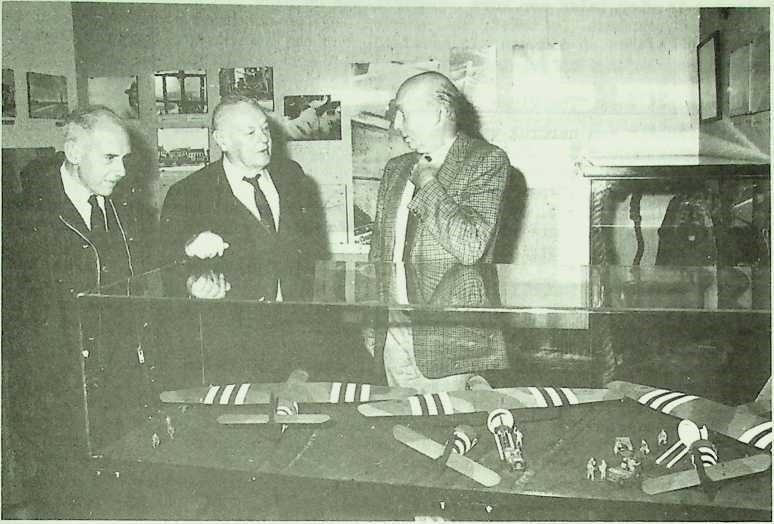
Brigadier Chatterton (centre) and Mr. Clarke (left) together with the Museum’s Director,-Mr. Wilhelm, looking at the model of three Horsa gliders. The model was made by Messrs. Belonje and Van Pelt (photo: B. de Reus)
New commemorative envelope available.
On the occasion of the 39th Airborne Commemoration, the Airborne Museum has had a special envelope printed, showing the Army Air Corps’ emblem and three Horsa gliders. Each envelope has its own number and only 4-75 have been printed.
The envelopes cost 5 Dutch Guilders each.
Telescope belonging to English sniper-rifle given to. Museum.
Evert van Roekel, the son of our Committee member Chris van Roekel, has donated to the Airborne Museum an English telescope, which he found himself, belonging to a sniper’s rifle. The telescope was found quite a time ago in the ditch behind the Old Church in Oosterbeek’s Benedendorp, whilst some digging operations were being carried out. The telescope more than likely landed in the ditch on the night of the 25th/26th September 19^, when the remainder of the First English Airborne Division retreated over the outermarches and finally over the Rhine.
How to obtain previously printed Newsletters.
There are regular requests as to whether it is possible to order copies of old Newsletters Old newsletters can be ordered (as long as there is still a supply) bv remitting a cheque to the value of 40 pence per old Newsletter, payable to Mr. Maynard, Society of Friends of the Airborne Museum. The price of 40 pence includes postage fees.
An explanatory text at the Airborne Monument in Oosterbeek.
On the 9th September last, a.pillar was placed at the Airborne Monument in Oosterb k In four languages, a summary is given of the Battle of Arnhem toge er W1 cription of the monument. The original text compiled by the Airborne ommi •’ was formerly contained in two glass-covered display cases, has been trans e the new pillar in its entirety.
“The Wings of Pegasus” reprinted.
“The Wings of Pegasus”, written by Brigadier George Chatterton O.B.E.,D.S,0. (Ret d) has recently been reprinted. The first edition of this book appeaxedin 19o2, and it describes the history of the Glider Pilot Regiment. The volunteers, who came from many different English regiments, were trained as glider pilots; moreover, pn the initiative of Chatterton, the glider pilots were given heavily military training so that they were able to fully participate in the fighting after having landed.
The first operation in which gliders were used on a major scale was during the landing on Sicily in June, 1943. However, due to inadequate time for all the neces¬sary preparations, together with the lack of experience, extremely heavy losses of life were suffered.Nevertheless, the landings in Normandy on the 6th June, 1944, and in Southern France on 11th August, 1944, went almost entirely according to plan. Then followed in September 1944, the landings in Eindhoven, Nijmegen and Arnhem. Chatterton himself landed at Nijmegen together with the officers of Headquarters of the Airborne Corps. The failure of the Battle of Arnhem was an eno urinous blow to the Glider Pilot Regiment; over half of the glider-pilots who landed never re¬turned home. In an effort to re-supply the enormous losses, 1500 RAF pilots who had just finished their training, were retrained as glider pilots.
The Rhine Crossing in March of 1945 was the last major airborne operation to take place during the war.
After the war, the Glider Pilot Regiment was radically reduced in number, and in 1951 the era of the military gliders came to an end. The remaining pilots were transferred to the Air Observation Post Flights of the RAF. On the 31st August, 1957, the Glider Pilot Regiment was officially dissolved, whereupon the new Army Air Corps immediately came into existence on the 1st September, which Corps still has its home-base in Middle Wallop.
In compiling his book, Chatterton used his own diary notes as well as eye-witness accounts of glider pilots. This new edition is from the “Battery Press” and costs 57 Dutch Guilders.
Autographed copies of “The Wings of Pegasus”.
During Brigadier Chatterton’s visit to the Airborne Museum, he offered to auto¬graph a few copies of his book, “The Wings of Pegasus”[these copies would then be sent to the Airborne Museum and be offered for sale. Should there be members inte¬rested in gaining an autographed copy of the book in question, they should send a postcard as soon as possible to: The Curator, Airborne Museum, Utrechtseweg 232 6862 AZ Oosterbeek. Only a limited number of books will be available (50) and the requests will be handled in consecutive order. There will be an extra charge of the postage expenses.
What Mini-story IV will be about.
“Black Thursday” was the name given by many of the English soldiers to Thursday 21st September, 19^44. On this day, heavy German motorised artillery was positioned right in front of the eastern lines held by the Lonsdale Force. It seemed that there would be a break-through. Until suddenly the German forces around’the peri¬meter underwent heavy shelling. This shelling came from the guns of the Second Army at Nijmegen. How did the encircled airborne troops and the Second Army manage to get into contact? This story will be published in Newsletter No. 13.
Newsletter No. 13.
Newsletter No. 13 will appear in January, 1984.

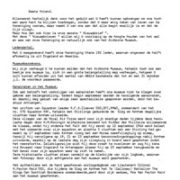
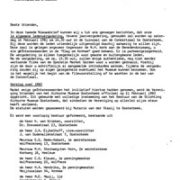
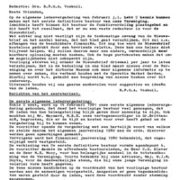
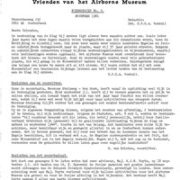
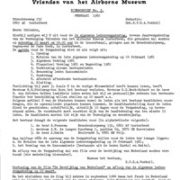
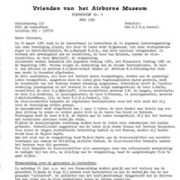
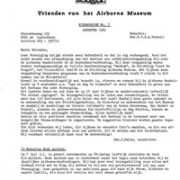
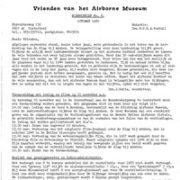
Plaats een Reactie
Vraag of reactie?Laat hier uw reactie achter.